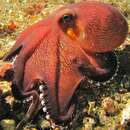en
names in breadcrumbs


Huffard et al. (2005) described in detail the remarkable bipedal locomotion of two octopus species, Amphioctopus marginatus (from Indonesia) and Abdopus aculeatus (from Australia), based on analyses of underwater video footage. These movements are distinctly different from from their normal crawling, which usually involves several arms sprawling around the body, using the suckers to push and pull the animal along. The bipedal movements of the two species studied differ significantly and the authors interpret these differences as achieving two different types of "crypsis in motion". Crypsis refers to the phenomenon whereby an animal's color pattern, behaviors, or other features make it "blend in" with the background. Crypsis, which can be achieved in a variety of ways, is the primary defense against predators used by most shallow-water octopuses, although there is some evidence that whether they choose to make themselves cryptic by modifying their physical appearance and/or behavior may depend on their assessment of the level of threat in their environment (Hanlon 1999). A number of octopus species are able to modify their appearance and behavior in such a way that they seem, at least to human observers, to resemble swimming fish, rocks, or other familiar objects in their habitat (Hanlon 1999). Both species studied by Huffard et al. (2005) use two arms for locomotion and the remaining six arms to provide camouflage. Each arm is on the sand for more than half of the stride, qualifying this behavior as a form of walking. The authors describe the bipedally locomoting A. marginatus as resembling a rolling coconut and A. aculeatus as resembling a clump of floating algae. They note that these animals achieve bipedal locomotion despite having only a hydrostatic skeleton, although this mode of locomotion has often been thought to require the opposition of muscle against a rigid skeleton.
Norman (2000) described an intriguing behavior by A. marginatus, observing that individuals of this species often carry around coconut shell halves, assembling them as a shelter only when needed. Finn et al. (2009) note that these shells offer no protection while being carried and, in fact, appear to be a burden as they force the octopus to use a novel and awkward form of locomotion which the authors describe as "stilt-walking". Finn et al. argue that this is the first known example of tool use by an invertebrate, if part of the definition of a tool is that it provides no benefit until it is used for a specific purpose. They argue that the fact that the shell is carried for future use rather than as part of a specific task differentiates this behaviour from other examples of object manipulation by octopuses, such as rocks being used to barricade lair entrances. Furthermore, the necessity to correctly assemble the separate parts (when transporting two shells) in order to create a single functioning tool sets this example of tool use apart from most or all examples previously known for invertebrates. The coconut shell carrying behavior is likely to have evolved using large empty bivalve shells prior to the relatively recent supply of the clean and light coconut shell halves discarded by the coastal human communities adjacent to the marine habitat of this species (Finn et al. 2009).
Amphioctopus marginatus (formerly known as Octopus marginatus) is a medium-sized octopus found in the tropical western Pacific and coastal waters of the Indian Ocean (M. Vecchione in litt. January 2010).
Diagnosis for genus Amphioctopus (from Kaneko 2008): Small to medium sized body (mantle length [ML]<140 mm); short arms (2-3 X ML), subequal in length, arm formula typically 4>3>2>1 or 4=3=2>1; moderate depth web with section A shallowest; moderate number of gill lamellae (6-11 in ocellates; 9-11 in non-ocellates); well-developed patch and groove system on skin surface.
Diagnosis for Amphioctopus marginatus (from Kaneko 2008): Body of moderate size (53-83 mm mantle length); ovoid (mantle width 51.3 - 58.8% of length). Head narrow (31.7 - 39% of mantle length). Arms short (2-3.5 X ML); width narrow to moderate (7.5 - 12.7); subequal in length (arm formula variable, typically dorsal pair shortest). Arm suckers in two rows; normal arms with 128-211 suckers (diameter of enlarged sucker 7.3 - 9.9% ML). Webs of moderate depth (to 17.4% of length of longest arm); web formula typically D>E>C>B>A. Right third arm of male hectocotylized, 87 - 90.3% length of opposite arm, with 110-123 suckers. Ligula small (length 1.3 - 2.1% of hectocotylized arm length); calamus moderate to large (length 28.9 - 51.4 of ligula length). Gills with 9 lamellae per demibranch. Funnel length short (length 31.3 - 37.1% of ML); free funnel length short (length 15.5 - 21.9% of ML). Funnel organ W-shaped. Male terminal organ moderate in length (length of terminal organ and diverticulum 23-35% of ML), straight, diverticulum well developed, coiled. Body of fresh and fixed specimens dark brown. Dorsal surface sculptured in relatively regular elongate patches to ridges defined by distinct darkened and branching grooves, most obvious as branching reticulations on lateral arm faces. Single superocular primary papilla present above each eye. Dorso-lateral faces of suckers white or pale-pink, forming contrasting white strip against dark brown or purple of aboral surfaces of arms.
Amphioctopus marginatus is found in the tropical western Pacific and coastal waters of the Indian Ocean (M. Vecchione in litt. January 2010).
The main body of Amphioctopus marginatus is typically around 8 centimeters long (~15 cm including arms). It has dark lines resembling veins on its body (hence the common name "Veined Octopus"). The arms are usually dark with contrasting white suckers. In many color displays, a lighter trapezoidal area can be seen immediately below the eye.
The current name for this species is Amphioctopus marginatus (Huffard and Hochberg 2005; M. Vecchione in litt. December 2009). It may actually be a complex of several species, though this question requires further study (Huffard and Hochberg 2005).